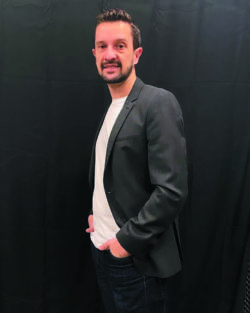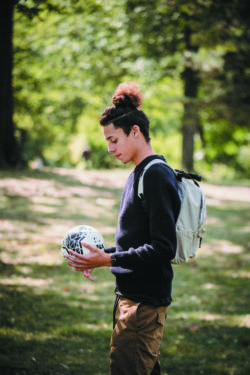Youth and sport: how to create tomorrow’s society?

Sport science teacher, associate professor in PE, at the Université Paris-Est Créteil, Guillaume Dietsch teaches mainly sociology, sport history and PE.
He is also coauthor of the book “A political history of PE from the 19th century to nowadays” published in 2022 with the edition De Boeck Supérieur. He publishes in 2024 “The Youth and the Sport: Thinking Tomorrow’s Society” where he addresses multiple societal challenges, with the aim of making them accessible beyond sport science students and specialists in sport issues and encouraging policymakers to take on these subjects.
“Young people are the main actors of change”
Switching between history, philosophy, sociology and scientific literature, Guillaume Dietsch explores current major societal issues through the lens of changes affecting youth and sport in his work “Youth and Sport. Think tomorrow’s society”. According to him, sport can assume an emancipatory dimension, but it is also necessary to address its abuses. A systemic approach interconnecting the different challenges is therefore necessary to analyse the impact of sport on our society.
Could you tell us more about one of the themes you are covering in your book?
The chapter about new technologies is revealing of the complexity of the themes covered in relation to youth. Even though we are talking about a hyperconnected generation, born with technology, I think that sport can have a leading role in their development. On the other hand, I am more concerned about the use of connected devices in sports; as well as practicing sports through communities of practitioners, following influencers, or using certain applications. This reflects a certain idea of our society that only focuses on performance and comparison, with tools initially thought to democratise sport. However, these tools can contribute to a phenomenon of abandoning sports practice, or to the development of forms of guilt, or even issues related to certain pathologies, especially mental health issues, when you don’t fit in the main body norms. Notwithstanding, it is necessary to raise these topics systemically, articulating them with other societal challenges in order to completely analyse the impact that sport can have in our lives and our societies.
How can the legacy of present major sports events be materialised for the youth? 
According to me, there is a kind of paradox because all major sports events are kept under a traditional model and present a show that isn’t suited to youth culture. On the other hand, some sports keep reaching a wide audience, football for example. The whole challenge for the Olympic and Paralympic Games might reside in the ambition to offer new practices and ways of consuming in alignment with the furthest public aspirations.
In fact, the question about the part that youth plays can raise some concerns about the symbolic legacy of the Games. Many studies made after London 2012 have shown that the event had close to no impacts on the population, especially on those who are the furthest from sport culture and from the legacy transmitted by parents. However, the role of the parents is crucial from the youngest age. Many studies suggest that today, the sport legacy is mainly transmitted through the father, and I believe that the ambition will be to go more and more through the mother’s one in the future. On the other hand, we must also enable single-parent family to accompany the legacy passed on to the child and allow this transmission.
Factually, in order to address legacy issues in its entirety, it is necessary to consider them to be linked with family issues but also with the evolution of free time that comes with it. A systemic analyse is also crucial here, otherwise we cannot reach this population and these new family structures.
How can these young people engage with this legacy and contribute to generating it themselves?
Elected representatives must take into consideration the voices and aspirations of young people in their public policies at a territorial and national scale. The example of public sport spaces is quite representative in this regard: we are usually most likely to have an imposition of sports installations that we believe to be interesting for the youth. It is notably the case for street workout spaces. We tend to think that these spaces answer a demand, bodybuilding, which seems to be confirmed by sport practices barometers. However, we never question the accessibility of these spaces to women, for their safety, or their proximity to downtown or villages. In consequences, we end up with sport spaces mainly occupied by men, or not used at all because they are too far from the periphery. While these spaces could be socialisation and reconnection areas between generations through sport, their implantation on the periphery of cities is symbolic and revealing of the image that we can have about the youth.
In 1 or 2 sentences, how do you see tomorrow’s sport?
Tomorrow’s sport is a model that evolves with society. It’s a sport that assumes to be a way to participate to societal change, as much in its emancipating dimension than in its alienating one.
“A Political history of PE. From the 19th century to nowadays”
 In this work, Guillaume Dietsch and Serge Durali retrace the political history of physical education (PE) since the 19th century when the discipline was built on a hygienic approach. It wasn’t until the 60s that sports were considered a subject of PE, with the idea of democratising sport in schools. This book then retraces those evolutions through educational policies and the transformation of French society.
In this work, Guillaume Dietsch and Serge Durali retrace the political history of physical education (PE) since the 19th century when the discipline was built on a hygienic approach. It wasn’t until the 60s that sports were considered a subject of PE, with the idea of democratising sport in schools. This book then retraces those evolutions through educational policies and the transformation of French society.
A second edition will come out by the end of the Olympic and Paralympic Games in order to question the role of PE and sports in schools and try to give perspectives on the legacy that will transmit the Games.
Extracts from the book
- “In their quest for identity construction, sport represents way more than a practice and imposes itself as a marker of the youth, a way to be and to think in the world: tomorrow’s society.” p.9
- “Young people shall be able to play an active part in the major challenges facing sport and the world of tomorrow. The sports offer and its accessibility need to be considered in light of the changing aspirations of the youth. They still need to be given the full recognition they deserve!” p.10
- “The new generation can get bored very quickly of one sport. Everything is consumed and lived in a “Netflix way”. This constant switching between sports more broadly reflects a society of immediacy in perpetual acceleration. Young people like sport, but they’d prefer it to be without constraints. They are directly connected to a virtual environment that undeniably transforms their relationship with sports practice.” P.132
- “Mobilized for the protection of the environment, conscious of health challenges concerning physical and sports activities, the youth is a major actor of change. Balancing individual satisfaction and contribution to the collective, they should be able to truly influence the policies of Youth and Sport.” p.145
- “To think about tomorrow’s society…It is to accept to do sport another way by promoting a sports model more social, mixed and sustainable. It is to develop physical and sportive activities that are intergenerational and to learn to practice together. It is to defend a project of emancipation through sport, for everyone, by enhancing diversity.” p.146
 This article was published in the magazine Sport and Citizenship n°57 : protecting sport integrity
This article was published in the magazine Sport and Citizenship n°57 : protecting sport integrity










 MEMBERSHIP
MEMBERSHIP CONTACT
CONTACT FACEBOOK
FACEBOOK